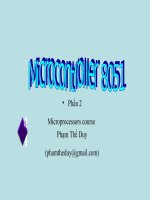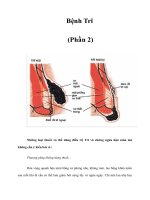Tài liệu CCENT/CCNA ICND1 phần 2 docx
Bạn đang xem bản rút gọn của tài liệu. Xem và tải ngay bản đầy đủ của tài liệu tại đây (1.71 MB, 10 trang )
xli
— Chapter 10, “Ethernet Switch Troubleshooting,” focuses on how to
tell if the switch is doing what it is supposed to, mainly through the
use of show commands.
— Chapter 11, “Wireless LANs,” explains the basic operation concepts of
wireless LANs, along with addressing some of the most common
security concerns.
■
Part III: IP Routing
— Chapter 12, “IP Addressing and Subnetting,” completes the
explanation of subnetting that was introduced in Chapter 5. More
importantly, it describes in detail how to perform the math and processes
to find the answers to many varieties of subnetting questions.
— Chapter 13, “Operating Cisco Routers,” is like Chapter 8, but with a
focus on routers instead of switches.
— Chapter 14, “Routing Protocol Concepts and Configuration,”
explains how routers forward (route) IP packets and how IP routing
protocols work to find all the best routes to each subnet. This chapter
includes the details of how to configure static routes and RIP version 2.
— Chapter 15, “Troubleshooting IP Routing,” suggests hints and tips
about how to troubleshoot problems related to layer 3 routing, including
a description of several troubleshooting tools.
■
Part IV: Wide-Area Networks
— Chapter 16, “WAN Concepts,” completes the conceptual materials
for WANs, continuing the coverage from Chapter 4 by touching on
Internet access technologies such as DSL and cable. It also covers the
concepts of Network Address Translation (NAT).
— Chapter 17, “WAN Configuration,” completes the main technical
topics, focusing on a few small WAN configuration tasks. It also covers
the WAN configuration tasks and NAT configuration using Cisco
Security Device Manager (SDM).
■
Part V: Final Preparation
— Chapter 18, “Final Preparation,” suggests a plan for final preparation
after you have finished the core parts of the book. It also explains the
many study options available in the book.
■
Part VI: Appendixes (in the Book)
— Appendix A, “Answers to the “Do I Know This Already?” Quizzes,”
includes the answers to all the questions from Chapters 1 through 17.
1828xbook.fm Page xli Thursday, July 26, 2007 3:10 PM
xlii
— Appendix B, “Decimal to Binary Conversion Table,” lists decimal
values 0 through 255, along with their binary equivalents.
— Appendix C, “ICND1 Exam Updates,” covers a variety of short
topics that either clarify or expand on topics covered earlier in the
book. This appendix is updated from time to time and is posted at
The most recent version available at
the time this book was published is included in this book as Appendix C.
(The first page of the appendix includes instructions on how to check to
see if a later version of Appendix C is available online.)
— The glossary defines all the terms listed in the “Definitions of Key
Terms” section at the conclusion of Chapters 1 through 17.
■
Part VII: Appendixes (on the CD)
The following appendixes are available in PDF format on the CD that accompanies
this book:
— Appendix D, “Subnetting Practice,” includes a large number of
subnetting practice problems. It gives the answers as well as explanations
of how to use the processes described in Chapter 12 to find the answers.
— Appendix E, “Subnetting Reference Pages.” Chapter 12 explains in
detail how to calculate the answers to many subnetting questions. This
appendix summarizes the process of finding the answers to several key
questions, with the details on a single page. The goal is to give you a
handy reference page to refer to when you’re practicing subnetting.
— Appendix F, “Additional Scenarios.” One method to improve your
troubleshooting and network analysis skills is to examine as many unique
network scenarios as possible, think about them, and then get some
feedback on whether you came to the right conclusions. This appendix
provides several such scenarios.
— Appendix G, “Subnetting Video Reference.” The DVD includes
several subnetting videos that show you how to use the processes covered
in Chapter 12. This appendix contains copies of the key elements from
those videos, which may be useful when you’re watching the videos
(so that you do not have to keep moving back and forth in the video).
— Appendix H, “Memory Tables,” contains the key tables and lists from
each chapter, with some of the content removed. You can print this
appendix and, as a memory exercise, complete the tables and lists. The
goal is to help you memorize facts that can be useful on the exams.
— Appendix I, “Memory Tables Answer Key,” contains the answer key
for the exercises in Appendix H.
1828xbook.fm Page xlii Thursday, July 26, 2007 3:10 PM
xliii
— Appendix J, “ICND1 Open-Ended Questions,” is a holdover from the
previous edition of this book. The first edition had some open-ended
questions to help you study for the exam, but the newer features make
these questions unnecessary. For convenience, the old questions are
included here, unedited since the last edition.
How to Use This Book to Prepare for the
ICND1 (640–822) Exam and CCENT Certification
This book was designed with two primary goals in mind: to help you study for the ICND1
exam (and get your CCENT certification), and to help you study for the CCNA exam
by using both this book and the CCNA ICND2 Official Exam Certification Guide. Using
this book to prepare for the ICND1 exam is pretty straightforward. You read each chapter
in succession and follow the study suggestions in Chapter 18.
For Chapters 1 through 17, you have some choices as to how much of the chapter you read.
In some cases, you may already know most or all of the information covered in a given
chapter. To help you decide how much time to spend on each chapter, the chapters begin
with a “Do I Know This Already?” quiz. If you get all the quiz questions correct, or if you
miss just one, you may want to skip to the “Exam Preparation Tasks” section at the end of
the chapter and perform those activities. Figure I-2 shows the overall plan.
Figure I-2
How to Approach Each Chapter of This Book
When you have completed Chapters 1 through 17, you can use the guidance listed in
Chapter 18 to perform the rest of the exam preparation tasks. That chapter includes the
following suggestions:
■
Check for the latest copy of Appendix C, which may
include additional topics for study.
Ta ke the “Do I Know This Already Quiz”
Read “Foundation Topics” Section
Read/do “Exam Preparation Tasks” To Next Chapter
Miss more
than 1:
Miss 1 or less, but
want more study
Miss 1 or less, want
to move on
1828xbook.fm Page xliii Thursday, July 26, 2007 3:10 PM
xliv
■
Practice subnetting using the tools available in the CD appendixes.
■
Repeat the tasks in all the chapters’ “Exam Preparation Tasks” chapter-ending
sections.
■
Review the scenarios in CD Appendix F.
■
Review all the “Do I Know This Already?” questions.
■
Practice the exam using the exam engine.
How to Use These Books to Prepare for the
CCNA 640–802 Exam
If you plan to get your CCNA certification using the one-exam option of taking the
CCNA 640-802 exam, you can use this book with the CCNA ICND2 Official Exam
Certification Guide. If you haven’t yet bought either book, you generally can get the pair
cheaper by buying both books as a two-book set called the CCNA Certification Library.
These two books were designed to be used together when you study for the CCNA exam.
You have two good options for the order in which to read the two books. The first and most
obvious option is to read this book and then move on to the ICND2 book. The other option
is to read all of ICND1’s coverage of one topic area, and then read ICND2’s coverage of
the same topics, and then return to ICND1. Figure I-3 outlines my suggested plan for
reading the two books.
Figure I-3
Reading Plan When You’re Studying for the CCNA Exam
Both reading plan options have some benefits. Moving back and forth between books helps
you focus on one general topic at a time. However, note that there is some overlap between
the two exams, so there is some overlap between the two books as well. From reader
Network Fundamentals
Final Preparation
Wide-Area Networks
IP Routing
LAN Switching
ICND1
Exam Certification Guide
Start
here
LAN Switching
IP Routing
Routing Protocols
Wide-Area Networks
Scaling the IP Address Space
Final Preparation
ICND2
Exam Certification Guide
1828xbook.fm Page xliv Thursday, July 26, 2007 3:10 PM
xlv
comments about the previous edition of these books, readers who were new to networking
tended to do better by completing all of the first book and then moving on to the second.
Readers who had more experience and knowledge before starting the books tended to prefer
following a reading plan like the one shown in Figure I-3.
Note that for final preparation, you can use the final chapter (Chapter 18) of the ICND2
book rather than the “Final Preparation” chapter (Chapter 18) of this book. Chapter 18 of
ICND2 covers the same basic activities as does this book’s Chapter 18, with reminders of
any exam preparation materials from this book that should be useful.
In addition to the flow shown in Figure I-3, when you study for the CCNA exam (rather
than the ICND1 and ICND2 exams), it is important to master IP subnetting before moving
on to the IP routing and routing protocol parts of the ICND2 book. The ICND2 book does
not review subnetting or the underlying math, assuming that you know how to find the
answers. Those ICND2 chapters, particularly Chapter 5 (“VLSM and Route
Summarization”), are much easier to understand if you can do the related subnetting math
pretty easily.
For More Information
If you have any comments about this book, you can submit them via
. Just go to the website, select Contact Us, and enter your
message.
Cisco might occasionally make changes that affect the CCNA certification. You should
always check and for the
latest details.
The CCNA certification is arguably the most important Cisco certification, although the
new CCENT certification might surpass CCNA in the future. CCNA certainly is the most
popular Cisco certification to date. It’s required for several other certifications, and it’s the
first step in distinguishing yourself as someone who has proven knowledge of Cisco.
The CCENT/CCNA ICND1 Official Exam Certification Guide is designed to help you attain
both CCENT and CCNA certification. This is the CCENT/CCNA ICND1 certification
book from the only Cisco-authorized publisher. We at Cisco Press believe that this book can
help you achieve CCNA certification, but the real work is up to you! I trust that your time
will be well spent.
1828xbook.fm Page xlv Thursday, July 26, 2007 3:10 PM









